
Dollar Academy
Encyclopedia
Dollar Academy was founded in 1818, which makes it the oldest co-educational day and boarding school in the world. The open campus occupies a 70 acres (283,280.2 m²)site in the centre of the thriving town of Dollar
in Central Scotland
, less than 40 minutes drive from the two main Scottish cities, Glasgow
and Edinburgh
. The school is located at the foot of the Ochil hills and surrounded by Clackmannanshire countryside.
While it has a reputation as one of the sportiest schools in Britain, Dollar Academy is, according to The Scotsman
, Scotland's best-performing school academically. The 2011 SQA exam results saw a 95% pass rate at Higher, 62% of which were at grade A. An impressive 38 students achieved a clean sweep of five or more Highers at grade A. Dollar Academy has also outstanding art and music facilities, with several large scale public performances and exhibitions each year, including a Christmas concert staged at the Usher Hall
, Edinburgh
.
Dollar Academy students have a reputation for success in University entry in medicine, law, engineering and business studies. Over 40% of leavers each year go on to study one of these subjects, usually at Scottish Universities such as St Andrews
and Edinburgh
, but also at leading English Universities such as Oxford
and Cambridge
.
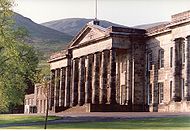 There are over 1250 students at Dollar Academy, making it the fourth largest independent school in Scotland. All based on a single campus, it is divided into three separate schools: the Prep School (Preps I to V for ages 5–10), the Junior School (Juniors I and II for ages 10–12) and the Senior School (Forms I to VI for ages 12 going on 18).
There are over 1250 students at Dollar Academy, making it the fourth largest independent school in Scotland. All based on a single campus, it is divided into three separate schools: the Prep School (Preps I to V for ages 5–10), the Junior School (Juniors I and II for ages 10–12) and the Senior School (Forms I to VI for ages 12 going on 18).
Around 100 of the students are boarders; the rest are day pupils, either from the village of Dollar itself or from the surrounding counties of Clackmannanshire, Stirlingshire, Perth and Kinross and Fife. Just 20% of the boarding students are from overseas, representing less than 4% of the total school roll. Foreign students come from a range of countries, including France
, Spain
, Germany
, Russia
, and China
. The remaining 80% of boarding students are UK nationals.
Dollar Academy has a wide range of activities on offer; there are over 70 sports and recreational activities which occupy students after the school day has finished and over the weekend. Dollar Academy has produced international competitors across many disciplines, most notably in Rugby and Shooting, but the emphasis is on taking part, with students continually challenged to try new and unusual activities.
, with students sitting a mixture of Standard Grade
s and Intermediates at the end of Form IV and Highers at the end of Form V/VI. Most courses in Form VI are at Advanced Higher level. A number of students study the Scottish Baccalaureate. All standard subjects are on offer at Dollar Academy. The school also teaches Classical Studies, Latin and Greek, ITC training is provided to all students, and music, art and drama is mandatory.
Specialised courses and industry placements are available to senior students who wish to study medicine, law, engineering and business. The teacher:student ratio at Dollar Academy is 9:1 and support is provided across all subjects. In 2011, the national pass rate for Scottish Higher exams was 75.2% ref: SQA. The Dollar Academy pass rate was 95%, with 62% of passes at grade A. The Governors' Bursary of £500 is awarded to those students who attain 5 As at band 1 in their Highers.
Dollar Academy's CCF (Combined Cadet Force
) is also very strong, having won the Scottish Schools' military skills competition for the last three years. The school was also the first Scottish school to win the Ashburton Shield at Bisley.
There are five periods in the day, each lasting one hour. First period begins at 9:15 am and finishes and 10:15 am, and is followed by second period which ends at 11:15 am. Between 11:15 am and 11:30 am is morning break (there is extended break on a Friday lasting an extra five minutes). Third period is from 11:30 am to 12:30 am, and is followed by lunch, which finishes at 1:25 pm. Fourth and fifth period follow, ending at 3:25 pm. Buses leave Dollar at 3:35 pm. After-school activities usually take place between 3:30 pm and 4:45 pm. 'Late buses' leave Dollar at 5:15 pm.
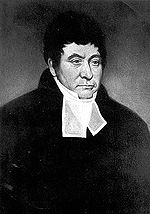
 Dollar was founded in 1818 at the bequest of John McNab or McNabb, a merchant who bequeathed part of his fortune - £65,000 - to provide "a charity or school for the poor of the parish of Dollar where I was born".
Dollar was founded in 1818 at the bequest of John McNab or McNabb, a merchant who bequeathed part of his fortune - £65,000 - to provide "a charity or school for the poor of the parish of Dollar where I was born".
McNabb died in 1802 but it took another sixteen years before the school opened it doors after much debate about how to use the bequest. It was in 1815 that the Rev. Andrew Mylne, Minister of Dollar, along with fellow Trustees conceived of a great academy to educate the boys and girls of the parish, and also pupils from outside Dollar, who would board with teachers. Full fees would be charged to ‘non-residenters’, while parish pupils would pay fees on a sliding scale, with some receiving free education. To attract pupils from outside the parish, excellent teachers would be appointed.
Mylne engaged the eminent architect, William Playfair, who designed a fitting structure with a splendid Doric façade and John McNabb’s School or Dollar Institution (later Dollar Academy) was finally opened in 1818, with Rev Dr Andrew Mylne as the first school Rector.
The original campus was landscaped into several gardens including two ponds. Curiously in the 19th century the school had a strong emphasis on horticulture, and pupils were each allocated plots on the extensive school grounds. Several curious rarities exist in the school grounds in arboricultural terms, including several sequoias
. In the 19th century, Dollar pupils sat the Cambridge Examinations or the Indian Civil Service Examinations. It was pioneering in its teaching of science at a time when most private schools followed an exclusively classical education.
McNabb’s coffin was discovered in the early 1930s in a crypt hidden in a disused warehouse in London. Former pupils had his remains cremated, and the ashes of Captain John McNabb now rest above the Bronze Doors of the school founded in his name.
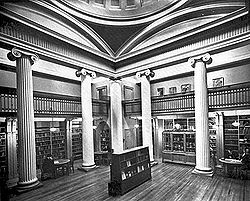 The principal school building was designed by renowned Scottish architect William Henry Playfair
The principal school building was designed by renowned Scottish architect William Henry Playfair
with its characteristic "bronze doors". The interior of the Playfair building was gutted by a fire in 1961, but Playfair's Greek-style facade remained intact and the school was re-opened in 1966 by former pupil Lord Heyworth and visited by The Queen and Prince Philip. The assembly hall dates from the 1960s rebuild. The school library is a "whispering gallery
" because of its domed ceiling.
There are numerous other buildings on the campus, including the Dewar Building for science, the Younger Building for mathematics and business studies, the Gibson Building for music, the Iona Building for home economics and the most recently built Maguire Building for sport, art and drama. There are also several rugby, cricket and football pitches, and new all-weather surface for hockey and tennis. Sport is supported by the Boys' and Girls' pavilions, the Games Hall and the swimming pool. In 2005, the new Maguire Building was opened with excellent facilities for Art, PE and Drama and with the circular Captain’s Room for conferences and meetings.
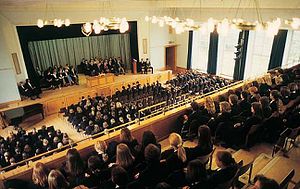 The original boarding accommodation was built at the same time as the original Playfair building. These houses were situated in Academy Place to accommodate teachers and boarders. Over the years these magnificent buildings have have been modernised and study bedrooms introduced. The existing boarding houses are all period buildings, refurbished to high specification. Boarding at Dollar was highly commended by a recent HMIe inspection.
The original boarding accommodation was built at the same time as the original Playfair building. These houses were situated in Academy Place to accommodate teachers and boarders. Over the years these magnificent buildings have have been modernised and study bedrooms introduced. The existing boarding houses are all period buildings, refurbished to high specification. Boarding at Dollar was highly commended by a recent HMIe inspection.
There are spaces for 99 boarders in the Academy's three boarding houses. Both weekly boarders (Monday - Friday) and full boarders are accepted.
Though the majority of pupils do not board, every pupil belongs to a House (girls) or corresponding Quint (boys). Originally there were five boys' houses, instituted in 1911, hence the term "quint". The Quint Cup and House Cup are awarded annually at Prize-Giving. Today there are four houses/quints:
Old Academicals' children are traditionally put into the same house as their Father/Mother/Brother/Sister. The names of Quints and houses were merged in 2009; previously, male quints followed the names: Castle (Atholl), Devon (Mar), Glen (Stewart), and Hill (Argyll). The fifth male quint was McNabb but this was dropped in 1937.
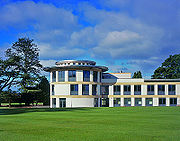 Each year Full Colours and Half Colours are awarded to senior pupils for achievement in sporting or cultural pursuits. These awards merit piping on the school blazer (blue for cultural, white for sporting) and/or a distinctive blazer badge. Sixth-year pupils are also given a distinctive silver tie, and prefects wear white and blue bands round the blazer sleeves.
Each year Full Colours and Half Colours are awarded to senior pupils for achievement in sporting or cultural pursuits. These awards merit piping on the school blazer (blue for cultural, white for sporting) and/or a distinctive blazer badge. Sixth-year pupils are also given a distinctive silver tie, and prefects wear white and blue bands round the blazer sleeves.
The Senior Six (or "Top Six") are the most senior prefects in the school, elected by a ballot of Forms IV, V and VI. A number of those with the highest numbers of votes go through to the "College of Cardinals", among whom a Head Boy, Head Girl and two deputies for each are elected.
Two school songs were composed in 1912, but neither was officially adopted. "Here in a Fair Green Valley..." by the poet W. K. Holmes and music by Marc Anthony became the official school song sung at prize-giving each year between 1929-1993. This was then replaced by the Academy Hymn, "O God of Bethel!" until 2007, when the popularity and metaphorical significance of "Will Your Anchor Hold?" (Hymn 412) caused it to be adopted for this purpose. The hymn is known as the "Dollar Anthem" and is often sung at rugby matches.
The Commemoration of the Founder is said by the Head Boy and Head Girl at prize-giving:
Other traditional events in the school calendar include: annual Christmas Dances, Form VI Dinner, Burns' Supper (Form VI), the Summer Ball (Form VI), the Junior Musical, the Senior Musical, the Sixth Form Play, the Christmas Carol Concert, the Teddy Bears' Picnic (Prep School), Prep School Sports Day, Sports Weekend and the biennial Sponsored Walk, which raised over £48,000 in 2007 for various charities.
Dollar, Clackmannanshire
Dollar is a small town in Clackmannanshire, Scotland. It is one of the Hillfoots Villages, situated between the Ochil Hills range to the north and the River Devon to the south. Dollar is on the A91 road, which runs from Stirling to St. Andrews. The town is around 3 miles east of Tillicoultry...
in Central Scotland
Central Region, Scotland
Central Region was a local government region of Scotland from 1975 to 1996. It is now divided into the council areas of Falkirk, Stirling, and Clackmannanshire, which had previously been districts within Central...
, less than 40 minutes drive from the two main Scottish cities, Glasgow
Glasgow
Glasgow is the largest city in Scotland and third most populous in the United Kingdom. The city is situated on the River Clyde in the country's west central lowlands...
and Edinburgh
Edinburgh
Edinburgh is the capital city of Scotland, the second largest city in Scotland, and the eighth most populous in the United Kingdom. The City of Edinburgh Council governs one of Scotland's 32 local government council areas. The council area includes urban Edinburgh and a rural area...
. The school is located at the foot of the Ochil hills and surrounded by Clackmannanshire countryside.
While it has a reputation as one of the sportiest schools in Britain, Dollar Academy is, according to The Scotsman
The Scotsman
The Scotsman is a British newspaper, published in Edinburgh.As of August 2011 it had an audited circulation of 38,423, down from about 100,000 in the 1980s....
, Scotland's best-performing school academically. The 2011 SQA exam results saw a 95% pass rate at Higher, 62% of which were at grade A. An impressive 38 students achieved a clean sweep of five or more Highers at grade A. Dollar Academy has also outstanding art and music facilities, with several large scale public performances and exhibitions each year, including a Christmas concert staged at the Usher Hall
Usher Hall
Usher Hall is a concert hall, situated on Lothian Road, in the west end of Edinburgh, Scotland. It has hosted concerts and events since its construction in 1914 and can hold approximately 2,900 people in its recently restored auditorium, which is well loved by performers due to its acoustics...
, Edinburgh
Edinburgh
Edinburgh is the capital city of Scotland, the second largest city in Scotland, and the eighth most populous in the United Kingdom. The City of Edinburgh Council governs one of Scotland's 32 local government council areas. The council area includes urban Edinburgh and a rural area...
.
Dollar Academy students have a reputation for success in University entry in medicine, law, engineering and business studies. Over 40% of leavers each year go on to study one of these subjects, usually at Scottish Universities such as St Andrews
St Andrews
St Andrews is a university town and former royal burgh on the east coast of Fife in Scotland. The town is named after Saint Andrew the Apostle.St Andrews has a population of 16,680, making this the fifth largest settlement in Fife....
and Edinburgh
Edinburgh
Edinburgh is the capital city of Scotland, the second largest city in Scotland, and the eighth most populous in the United Kingdom. The City of Edinburgh Council governs one of Scotland's 32 local government council areas. The council area includes urban Edinburgh and a rural area...
, but also at leading English Universities such as Oxford
Oxford
The city of Oxford is the county town of Oxfordshire, England. The city, made prominent by its medieval university, has a population of just under 165,000, with 153,900 living within the district boundary. It lies about 50 miles north-west of London. The rivers Cherwell and Thames run through...
and Cambridge
Cambridge
The city of Cambridge is a university town and the administrative centre of the county of Cambridgeshire, England. It lies in East Anglia about north of London. Cambridge is at the heart of the high-technology centre known as Silicon Fen – a play on Silicon Valley and the fens surrounding the...
.
Overview

Around 100 of the students are boarders; the rest are day pupils, either from the village of Dollar itself or from the surrounding counties of Clackmannanshire, Stirlingshire, Perth and Kinross and Fife. Just 20% of the boarding students are from overseas, representing less than 4% of the total school roll. Foreign students come from a range of countries, including France
France
The French Republic , The French Republic , The French Republic , (commonly known as France , is a unitary semi-presidential republic in Western Europe with several overseas territories and islands located on other continents and in the Indian, Pacific, and Atlantic oceans. Metropolitan France...
, Spain
Spain
Spain , officially the Kingdom of Spain languages]] under the European Charter for Regional or Minority Languages. In each of these, Spain's official name is as follows:;;;;;;), is a country and member state of the European Union located in southwestern Europe on the Iberian Peninsula...
, Germany
Germany
Germany , officially the Federal Republic of Germany , is a federal parliamentary republic in Europe. The country consists of 16 states while the capital and largest city is Berlin. Germany covers an area of 357,021 km2 and has a largely temperate seasonal climate...
, Russia
Russia
Russia or , officially known as both Russia and the Russian Federation , is a country in northern Eurasia. It is a federal semi-presidential republic, comprising 83 federal subjects...
, and China
China
Chinese civilization may refer to:* China for more general discussion of the country.* Chinese culture* Greater China, the transnational community of ethnic Chinese.* History of China* Sinosphere, the area historically affected by Chinese culture...
. The remaining 80% of boarding students are UK nationals.
Dollar Academy has a wide range of activities on offer; there are over 70 sports and recreational activities which occupy students after the school day has finished and over the weekend. Dollar Academy has produced international competitors across many disciplines, most notably in Rugby and Shooting, but the emphasis is on taking part, with students continually challenged to try new and unusual activities.
Academic
Dollar Academy follows the Scottish education systemEducation in Scotland
Scotland has a long history of universal provision of public education, and the Scottish education system is distinctly different from the other countries of the United Kingdom...
, with students sitting a mixture of Standard Grade
Standard Grade
Standard Grades are Scotland's educational qualifications for students aged around 14 to 16 years, which are due to be fully replaced in 2014 when Scottish Qualifications Authority's Higher Still system becomes the main qualifications as part of the major shake up of Scotland's education system as...
s and Intermediates at the end of Form IV and Highers at the end of Form V/VI. Most courses in Form VI are at Advanced Higher level. A number of students study the Scottish Baccalaureate. All standard subjects are on offer at Dollar Academy. The school also teaches Classical Studies, Latin and Greek, ITC training is provided to all students, and music, art and drama is mandatory.
Specialised courses and industry placements are available to senior students who wish to study medicine, law, engineering and business. The teacher:student ratio at Dollar Academy is 9:1 and support is provided across all subjects. In 2011, the national pass rate for Scottish Higher exams was 75.2% ref: SQA. The Dollar Academy pass rate was 95%, with 62% of passes at grade A. The Governors' Bursary of £500 is awarded to those students who attain 5 As at band 1 in their Highers.
Extra curricular
The school has a well-known pipe band, which has won the Scottish Schools CCF Pipes and Drums competition every year since 2000..Dollar Academy's CCF (Combined Cadet Force
Combined Cadet Force
The Combined Cadet Force is a Ministry of Defence sponsored youth organisation in the United Kingdom. Its aim is to "provide a disciplined organisation in a school so that pupils may develop powers of leadership by means of training to promote the qualities of responsibility, self reliance,...
) is also very strong, having won the Scottish Schools' military skills competition for the last three years. The school was also the first Scottish school to win the Ashburton Shield at Bisley.
The School Day
The school day begins at 8:45 am, when pupils must be in Registration in their Form Tutor Groups to be registered at the beginning of each day. In each year there are around 8 or 9 such classes, each of about 17–20 pupils. On Mondays, Wednesdays and Fridays pupils attend Morning Assembly from 9:00 am to 9:15 am. This consists of an academic parade, a hymn, a bible reading and a prayer, followed by announcements about the forthcoming days. On Tuesdays and Thursdays there is extended registration which lasts until 9:10 am, with classes starting five minutes earlier than usual.There are five periods in the day, each lasting one hour. First period begins at 9:15 am and finishes and 10:15 am, and is followed by second period which ends at 11:15 am. Between 11:15 am and 11:30 am is morning break (there is extended break on a Friday lasting an extra five minutes). Third period is from 11:30 am to 12:30 am, and is followed by lunch, which finishes at 1:25 pm. Fourth and fifth period follow, ending at 3:25 pm. Buses leave Dollar at 3:35 pm. After-school activities usually take place between 3:30 pm and 4:45 pm. 'Late buses' leave Dollar at 5:15 pm.
History


McNabb died in 1802 but it took another sixteen years before the school opened it doors after much debate about how to use the bequest. It was in 1815 that the Rev. Andrew Mylne, Minister of Dollar, along with fellow Trustees conceived of a great academy to educate the boys and girls of the parish, and also pupils from outside Dollar, who would board with teachers. Full fees would be charged to ‘non-residenters’, while parish pupils would pay fees on a sliding scale, with some receiving free education. To attract pupils from outside the parish, excellent teachers would be appointed.
Mylne engaged the eminent architect, William Playfair, who designed a fitting structure with a splendid Doric façade and John McNabb’s School or Dollar Institution (later Dollar Academy) was finally opened in 1818, with Rev Dr Andrew Mylne as the first school Rector.
The original campus was landscaped into several gardens including two ponds. Curiously in the 19th century the school had a strong emphasis on horticulture, and pupils were each allocated plots on the extensive school grounds. Several curious rarities exist in the school grounds in arboricultural terms, including several sequoias
Sequoioideae
Sequoioideae is a subfamily in the Cupressaceae family, with three genera.-Genera:The three redwood subfamily genera are: Sequoia and Sequoiadendron of California and Oregon, USA; and Metasequoia in China. The redwood species contains the largest and tallest trees in the world. These trees can live...
. In the 19th century, Dollar pupils sat the Cambridge Examinations or the Indian Civil Service Examinations. It was pioneering in its teaching of science at a time when most private schools followed an exclusively classical education.
McNabb’s coffin was discovered in the early 1930s in a crypt hidden in a disused warehouse in London. Former pupils had his remains cremated, and the ashes of Captain John McNabb now rest above the Bronze Doors of the school founded in his name.
Architecture

William Henry Playfair
William Henry Playfair FRSE was one of the greatest Scottish architects of the 19th century, designer of many of Edinburgh's neo-classical landmarks in the New Town....
with its characteristic "bronze doors". The interior of the Playfair building was gutted by a fire in 1961, but Playfair's Greek-style facade remained intact and the school was re-opened in 1966 by former pupil Lord Heyworth and visited by The Queen and Prince Philip. The assembly hall dates from the 1960s rebuild. The school library is a "whispering gallery
Whispering gallery
A whispering gallery is a gallery beneath a dome, vault, or enclosed in a circular or elliptical area in which whispers can be heard clearly in other parts of the building....
" because of its domed ceiling.
There are numerous other buildings on the campus, including the Dewar Building for science, the Younger Building for mathematics and business studies, the Gibson Building for music, the Iona Building for home economics and the most recently built Maguire Building for sport, art and drama. There are also several rugby, cricket and football pitches, and new all-weather surface for hockey and tennis. Sport is supported by the Boys' and Girls' pavilions, the Games Hall and the swimming pool. In 2005, the new Maguire Building was opened with excellent facilities for Art, PE and Drama and with the circular Captain’s Room for conferences and meetings.
Boarding Houses

There are spaces for 99 boarders in the Academy's three boarding houses. Both weekly boarders (Monday - Friday) and full boarders are accepted.
- Argyll House - Girls aged 10–18
- Heyworth House - Girls aged 10–18
- McNabb-Tait House - Boys aged 10–18
Though the majority of pupils do not board, every pupil belongs to a House (girls) or corresponding Quint (boys). Originally there were five boys' houses, instituted in 1911, hence the term "quint". The Quint Cup and House Cup are awarded annually at Prize-Giving. Today there are four houses/quints:
Female and Male (Quints)
- Atholl (RedRedRed is any of a number of similar colors evoked by light consisting predominantly of the longest wavelengths of light discernible by the human eye, in the wavelength range of roughly 630–740 nm. Longer wavelengths than this are called infrared , and cannot be seen by the naked eye...
) - Mar (YellowYellowYellow is the color evoked by light that stimulates both the L and M cone cells of the retina about equally, with no significant stimulation of the S cone cells. Light with a wavelength of 570–590 nm is yellow, as is light with a suitable mixture of red and green...
) - Stewart (BlueBlueBlue is a colour, the perception of which is evoked by light having a spectrum dominated by energy with a wavelength of roughly 440–490 nm. It is considered one of the additive primary colours. On the HSV Colour Wheel, the complement of blue is yellow; that is, a colour corresponding to an equal...
) - Argyll (GreenGreenGreen is a color, the perception of which is evoked by light having a spectrum dominated by energy with a wavelength of roughly 520–570 nanometres. In the subtractive color system, it is not a primary color, but is created out of a mixture of yellow and blue, or yellow and cyan; it is considered...
)
Old Academicals' children are traditionally put into the same house as their Father/Mother/Brother/Sister. The names of Quints and houses were merged in 2009; previously, male quints followed the names: Castle (Atholl), Devon (Mar), Glen (Stewart), and Hill (Argyll). The fifth male quint was McNabb but this was dropped in 1937.
Traditions

The Senior Six (or "Top Six") are the most senior prefects in the school, elected by a ballot of Forms IV, V and VI. A number of those with the highest numbers of votes go through to the "College of Cardinals", among whom a Head Boy, Head Girl and two deputies for each are elected.
Two school songs were composed in 1912, but neither was officially adopted. "Here in a Fair Green Valley..." by the poet W. K. Holmes and music by Marc Anthony became the official school song sung at prize-giving each year between 1929-1993. This was then replaced by the Academy Hymn, "O God of Bethel!" until 2007, when the popularity and metaphorical significance of "Will Your Anchor Hold?" (Hymn 412) caused it to be adopted for this purpose. The hymn is known as the "Dollar Anthem" and is often sung at rugby matches.
The Commemoration of the Founder is said by the Head Boy and Head Girl at prize-giving:
Other traditional events in the school calendar include: annual Christmas Dances, Form VI Dinner, Burns' Supper (Form VI), the Summer Ball (Form VI), the Junior Musical, the Senior Musical, the Sixth Form Play, the Christmas Carol Concert, the Teddy Bears' Picnic (Prep School), Prep School Sports Day, Sports Weekend and the biennial Sponsored Walk, which raised over £48,000 in 2007 for various charities.
Rectors
- The Revd Dr Andrew Mylne (1818–1850)
- The Revd Dr Thomas Burbidge (1850–1851)
- The Revd John Milne (1851–1868)
- The Revd Dr William Barrack (1868–1878)
- George Thom (1878–1902)
- Charles Dougall (1902–1923)
- Hugh Martin (1923–1936)
- Harry Bell (1936–1960)
- James Millar (1960–1962) - Acting Rector
- Graham Richardson (1962–1975)
- Ian Hendry (1975–1984)
- Lloyd Harrison (1984–1994)
- John Robertson (1994–2010)
- David Knapman (2010–present)
Prize Day speakers
This list is incomplete, and lists speakers from 1949 to the present. The suffix FP denotes a former pupil of the Academy.Notable former teachers
- William TennantWilliam TennantWilliam Tennant , Scottish scholar and poet, was born at Anstruther, Fife.He was lame from childhood. His father sent him to the University of St Andrews, where he remained for two years, and on his return he became clerk to one of his brothers, a corn factor...
(1784–1848), linguist and poet (Master of Classical and Oriental Languages) - Patrick Syme (1774–1845), artist (Art Master)
- George Paxton Young (1818–1889), philosopher (Mathematics Master)
- Andrew BellAndrew Bell (educationalist)Andrew Bell was a Scottish Anglican priest and educationalist who pioneered the Madras System of Education in schools and was the founder of Madras College, a secondary school in St. Andrews.-His life and work:Andrew Bell was born at St. Andrews, in Scotland on 27 March 1753 and attended St...
(1753–1832), educationalist and divine (Mathematics Master) - Andrew Crawfurd (1787–1868), antiquarian and doctor (Chair of Natural Philosophy)
- Patrick Gibson (1782–1829), landscape painter (Professor of Painting)

